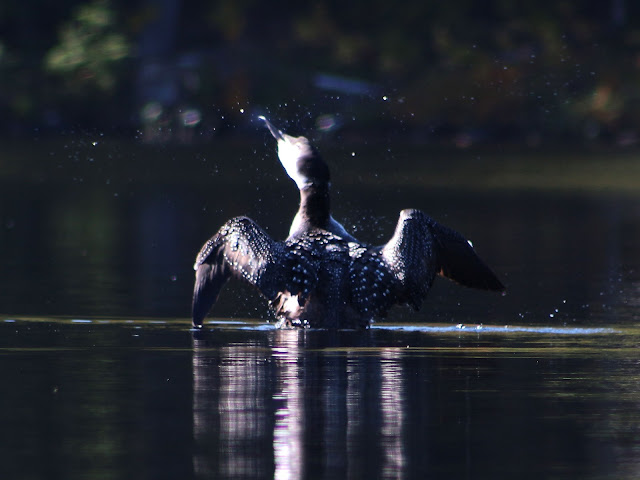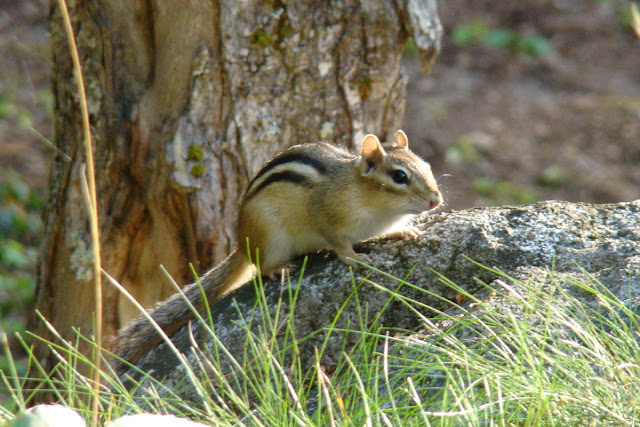The gorgeous, warm weather just keeps coming our way, and people are taking every advantage of it while it lasts.
 |
| Fishermen in the mornings |
 |
| Boaters enjoying their last few outings before the boats come out for the winter |
Here it is in late October and we haven't even had a hard frost yet around lake, though on the coldest morning (Tuesday) there was a touch of frost in areas most exposed to radiational cooling, evident on the smallest leaves suspended above the warm earth.
 |
| First hint of frost for the year |
Even with warm nights, they have been cool enough for mist to form over the still-warm water on most mornings.
And nothing can stop what must happen; even though the foliage is still beautiful, leaves are starting to pile up on the forest floor, still bedecked in their autumn finery.
As someone said this week, "we're going to pay for this!"
I noted last week the increased animal activity as they prepare for winter, and this week I had a couple of fun and exciting moments. The first was seeing a mink running along the shoreline in the morning, poking in every nook and cranny in the bank looking for breakfast. It was too quick to catch a picture, but here's one from last fall.

The second was a little more alarming. I was running in the woods on a trail with soft pine needles under foot, making little noise as soon became apparent. Suddenly, right over me was a huge object, flapping silently as it flew from behind me, right over my head, and down the trail in front of me. I've never ducked so fast. It was a huge barred owl that must have been sitting on a branch over the trail looking away from me as I approached. As I ran underneath, it was startled and took flight right over my head. It only flew a short way down the trail and perched in a tree just off the path so I had a great look at this magnificent bird. But it didn't stay long and took off again on its silent flight into the forest. Quite a heart stopping moment. Here's a picture of a barred owl taken in the same area last year.
It's likely the same bird, as barred owls are very much home-bodies. Barred owls have been banded, and one has never been found more than six miles from where it was banded.
We continue to have lots of Wood Ducks coming by Lake Wicwas this fall; every day there are flocks ranging from two or three up to well over a dozen.
Someone asked where they are coming from and where they are going, so I looked up wood ducks and here's what I found, most of it from Stokes' "A Guide to Bird Behavior" (Volume III, by Donald and Lillian Stokes, Little, Brown and Company, 1989).
Wood ducks are the only perching duck in the northeast, having well-developed claws for perching on branches and nesting in tree cavities.
 |
| This picture is from 2016 |
Much like the beaver, they were nearly exterminated in the early 1800s as the European settlers cleared away their nesting habitat and hunted them extensively. Conservation efforts started to bring them back, but then the hurricane of 1938 brought another blow (no pun intended) by destroying many of the large trees needed for nesting. The Great Meadows National Wildlife Refuge in Concord Massachusetts started a program of constructing nesting boxes for them, which was successful and soon copied in other areas, and there is now a healthy population of these pretty birds.
Hunting of them is once again permitted, which accounts for the shotgun blasts heard around the lake at exactly 30 minutes before sunrise this time of year. Early morning and late evening is when they are most visible, which unfortunately means poor lighting for pictures, but every now and then one stops by in the sunshine.
 |
| Mr. and Mrs. Wood Duck |
Stokes reports that New England wood ducks (and I presume birds from Canada as well) migrate down to the Maryland area and then spread out along the mid-Atlantic coast, so I expect New Hampshire's lakes are a good stopping point to rest and stretch their wings along their way.
Finally, perhaps traveling through Meredith Center this week you saw that the church is having its steeple renovated, the tall white spire contrasting sharply against the autumn sky.
 |
| Not a job for acrophobiacs |
It is one of the most beautiful times of year in New England, and I'll take this weather for as long as mother nature can fend off old man winter.
 |
| Crockett's ledge, shortly after sunrise |
























































